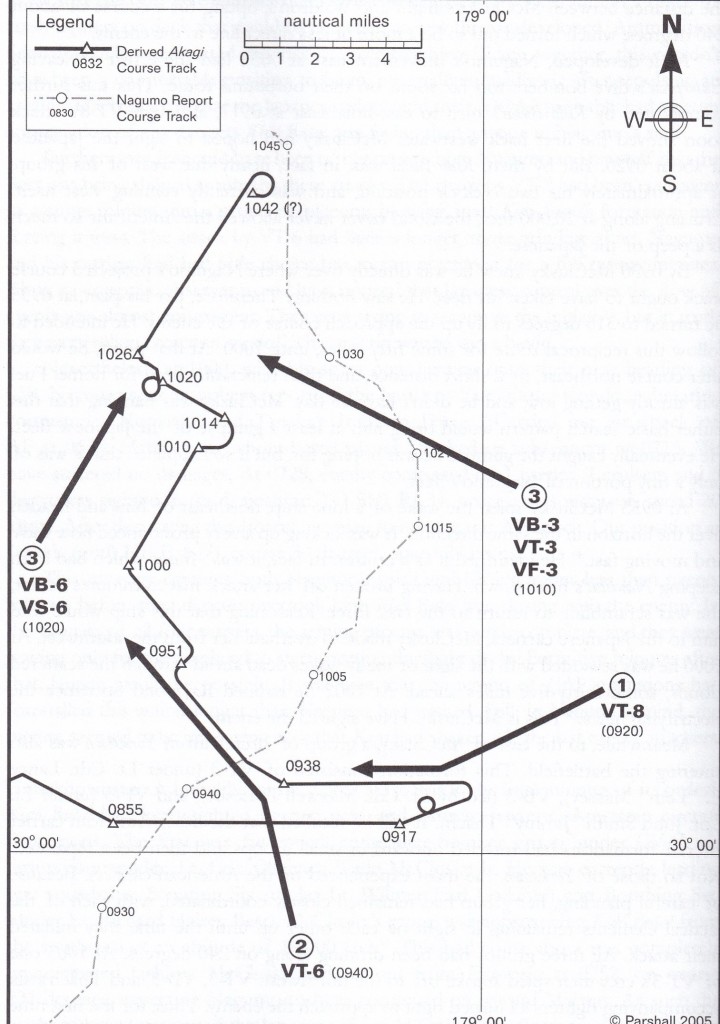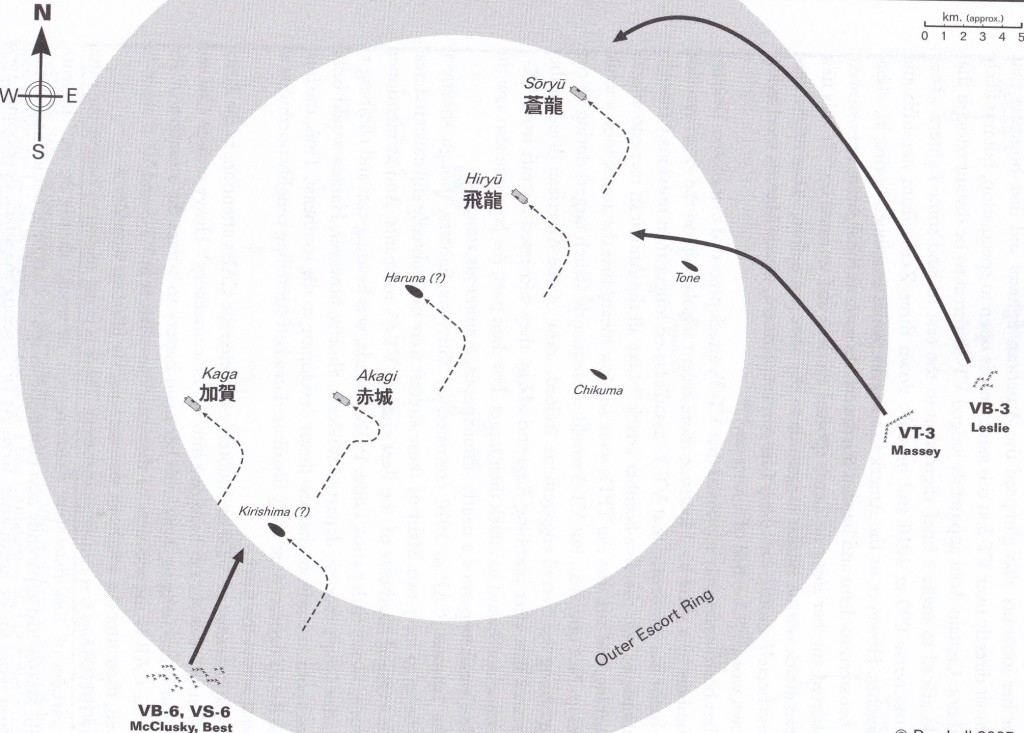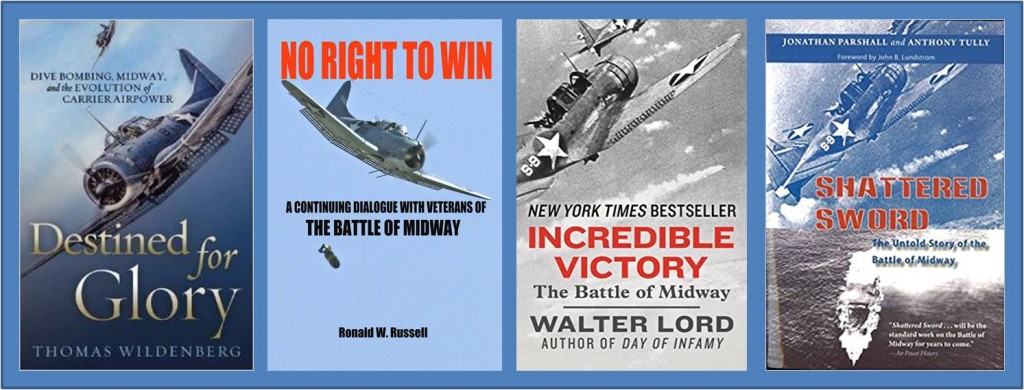Blown Slick Series #13 Part 5
The Battle of Midway
Paradox and Redemption: 4 to 7 June 1942
Among the many gems is a reminder to all who study mankind’s self-inflicted cataclysm: “Yet the overwhelming reality during the war…is that nobody knew how it would go.” Winds of War/War and Remembrance, Herman Wouk
Before the battle was joined there was no way the Japanese could have lost it…once it began, there was no way they could have won it. The Barrier and the Javelin, H.P. Willmott
The Battle of Midway occurred six months after Japan’s attack on Pearl Harbor and one month after the Battle of the Coral Sea. Under overall command in the Pacific of Admiral Chester Nimitz, Admirals Frank Jack Fletcher, and Raymond A. Spruance – neither a naval aviator – defeated an attacking fleet of the Imperial Japanese Navy under Admirals Isoroku Yamamoto, Chuichi Nagumo, and Nobutake Kondo near Midway Atoll, in the second only battle of aircraft carriers vs. aircraft carriers. Inflicting the loss of all four IJN carriers, the U.S. victory is arguably the most well known, researched, scrutinized and written about naval battle in history. Military historian John Keegan called it “the most stunning and decisive blow in the history of naval warfare.”
Indeed, in the “common wisdom,” the battle has not only been considered the decisive battle of the Pacific war, it has evoked the words/terms miracle, incredible, tide-turning, and no right to win. As noted in 2005 in the much heralded book and basis for much of the re-thinking of the battle, Shattered Sword,
the defining moment will always be the devastating and seemingly last-minute attack of American dive bombers against the Japanese carrier force at 1020 … hurling down from the heavens to drop their bombs on helpless Japanese carriers, their decks packed with aircraft just moments away from taking off
As it turns out, over the long years since the battle, multiple controversies, paradoxes, and myths have sprung up and gained traction. Some participants have gone to their graves steadfastly claiming competing stories. The two most persistent “myths” are that the Americans faced overwhelming odds and that the Bombing 6 (VB-6) Dauntless dive bombing of the carriers Kaga and Akagi occurred with their flight decks full within five minutes of launching against the American carriers. While there are multiple reasons, one of the most crucial is the reliance of multiple researchers and authors on the 1951 (1955 U.S. translation) book Midway – the Battle That Doomed Japan by Akagi’s airwing commander Mitsuo Fuchida .
While there is a huge library of books on the battle by noted historians and authors, the previously noted Shattered Sword by Jonathan Parshall and Anthony Tully has delved deeply into Japanese sources. Its research and focus on the battle has shined a bright light into dark corners and revealed much needed hidden or partially obscured details. Much that was found draws into question significant aspects of Fuchida’s version of events. It also provides explanations of events that had never been quite reconciled. Sword has been a major resource for this series and is most highly recommended.
There is so much detail and complexities related to the battle that no short rendition can do the battle justice, and interested readers should explore the many well researched books. A few are recommended below.
Here it seems worthwhile to note that while RememberedSky always makes effort to honor the participants of the Battle of Midway each June 4th, the focus of this sub-series is on the aircraft carrier in warfare, with the battles being the vehicle for discussion. The second piece, Series #13 Part 6, will discuss the Japanese loss factors and the third Part 7 take on reflection on the carriers and how they were used and implications. Below is a short overview for perspective that leverages updated graphics of the battle to bring clarification stemming mostly from Shattered Sword.
Figure 1: The Set-up
The Japanese operation, like the earlier attack on Pearl Harbor, sought to eliminate the United States as a strategic power in the Pacific, thereby giving Japan a free hand in establishing its Greater East Asia Co-Prosperity Sphere and was an element of expanding IJN control. As part of an overall “barrier” strategy to extend Japan’s defensive perimeter, Operation Mo focused on Port Moresby resulting in the May Battle of the Coral Sea Both operations were considered preparatory for further attacks against Fiji, Samoa, and Hawaii itself. Yamamoto expected to lure the American aircraft carriers into a trap after occupying Midway. He leveraged the Doolittle air raid on Tokyo to insure support from Japanese authority including a reluctant Army senior staff. The Japanese hoped another demoralizing defeat would force the U.S. to capitulate in the Pacific War and thus ensure Japanese dominance in the Pacific.
Four Japanese aircraft carriers faced off against three U.S. aircraft carriers and Midway Atoll defenses None of the remainder of the overwhelming Japanese force was in a position to affect the outcome of the battle including three small carriers used to execute a combined attack in the Aleutian Islands. Admiral Yamamoto’s plan was seriously flawed – overly complex and based on what he thought the U.S. Navy would do rather than what they could do. While his overall strength was more than the American, at the point of battle he was actually outnumbered (248 Japanese aircraft to 360 U.S. aircraft) – needlessly.
Admiral Nimitz, on the other hand, had a good plan based on exceptional intelligence that gave the us the crucial element of surprise and thus had good reason to believe that he was taking a “calculated risk” with a reasonable chance of success; he did not believe he was making a desperate gamble with the precious remaining U.S. aircraft carriers.
As a result in the execution, as the commander of the Japanese carrier task force, Vice Admiral Chuichi Nagumo launched a strike on Midway, he had no clue that 152 carrier aircraft from Enterprise, Hornet, and Yorktown were en route to attack him (only at 0820 did he even know one U.S. carrier was even in the area).
The first waves of U.S. attacks on the IJN carriers originating from Midway Island were completely ineffective and slaughtered in multiple separate, extremely valiant, but futile attacks. But it must be noted, the raids from Midway, and the ferocious resistance of Marine AAA on Midway to the Japanese morning attack, instigated the dynamic for Admiral Nagumo in regard to arming his aircraft for another strike on Midway or for attack on the U.S. carriers.
From the U.S. perspective, given the decision to launch at extreme range by Admiral Spruance, the launch cycle of three types of aircraft with different speeds and capabilities, from three different carriers, weather/visibility, need for radio silence, combined with the decision to delay Yorktown’s launch by Admiral Fletcher, the strike unfortunately fractured into at least seven uncoordinated groups. In addition some aircraft were heading in directions that would miss the Japanese carriers entirely.
Figure 2 provides graphic depiction of location AND significantly timing of the Devastator torpedo squadrons (VT-8, VT-6 and VT-3) and the Dauntless dive bomber squadrons (VB-6, VS-6, and VB-3) during the crucial time frame of the attack.
Figure 2; Reader Situational Awareness aide – “American air attacks on Kido Butai. 0920-1020. This illustration shows how the Japanese carrier formation was shoved in new directions as a result of the ongoing American attacks.” Shattered Sword (2005)
Figure 3 then shows the attack based on the individual IJN carrier positions resulting from the twisting and turning of each carrier as effected by the torpedo squadron attacks. While earlier accounts have used the VT attacks as basis for bringing Japanese fighters down to water level, leaving the Dauntless bombers free of threat, the timing shown in the graphics indicate that the fighters had time to climb and re-position.
Here from “…Sword“
it should have been of concern to both Nagumo and his staff that the fleet was being shoved around by these attacks. The attack by VT-8 had been equivalent to a stone thrown into a group of pigeons, blowing apart Ki’do Butai’s formation and forcing it west. The attack by VT-6 had been a longer, more grinding affair. Nagumo and his carriers had had little choice but to run northwest for a full twenty minutes. Thus, a perceptive observer would have noticed that Japanese control over the flow of events was almost nonexistent. They were trying to recapture the initiative, but in truth they were still in “reaction mode.” This was no way to win a battle.
The four carriers had to constantly maneuver because of the VT squadron attacks. Flight deck activity was focused on launching more fighters not getting ready for a strike on the U.S. carriers. The torpedo squadrons main contribution then was not in terms of the CAP fighter positioning, rather their actions and bravery forced such action by the IJN carriers that they disrupted the whole counteroffensive activities of the Japanese.
Figure 3; Reader Situational Awareness aide – “Kido Butai immediately before attacks. The Carriers are line abreast, with the two carrier divisions widely separated.” Shattered Sword (2005)
The dive bombing attacks by the three Dauntless squadrons would leave Kaga, Akagi and Soryu in ruins. The Hiryu would survive to get off two separate strikes that left the Yorktown in critical condition, before a late-afternoon U.S. counterstrike left her also flaming wreck; all four Japanese carriers would eventually be scuttled. A Japanese heavy cruiser, the Mikuma, which had been escorting her sister the Mogami, seriously damaged in a collision, was sunk on 6 June by carrier aircraft. The cost to the Japanese was all four carriers involved – Akagi, Kaga, Soryu, Hiryu, and all 248 carrier aircraft, plus a heavy cruiser.
For the U.S., just as it appeared that heroic damage control efforts would save the Yorktown, she was torpedoed, along with the destroyer Hammann, by Japanese submarine I-168 on 6 Jun. Hammann sank immediately, and Yorktown went down the morning of 7 June. The U.S. carriers Enterprise (CV-6) and Hornet (CV-8) were never found by Japanese strike aircraft, although both their air groups suffered extensive losses. The cost to the U.S. was sinking of the Yorktown and the Hammann, about 145 aircraft lost and 307 killed.
Although more than 75% of the Japanese aviators lived to fight again, the more telling costs were the carriers themselves, the crew and the built up organizational and operational experience. Over 3,000 Japanese sailors lost their lives.
It should be noted that the two battles – Coral Sea and Midway – remain highly coupled. Had either Shokaku or Zuikaku been at Midway, the battle probably would have been unwinnable for Enterprise, Hornet and Yorktown. Again from Shattered Sword:
In the end, Midway stands as the most important battle of the Pacific war, not because it was decisive in an absolute sense, and not because it won the war in a day, but because of its immediate practical effects on American military options in the Pacific. In the succinct words of the Naval War College study of the battle, Midway “put an end to Japanese offensive action … and … [restored] the balance of naval power in the Pacific.” In this modern era of unchallenged American naval supremacy, merely restoring parity may not seem like much of an accomplishment. But it must be recalled that Midway was fought “between one navy at the peak of its strength and another if not at its nadir then close to it.” In the dark months of 1942, being able to claw back to parity was an enormous achievement. Thus, Midway clearly delineated where and when the strategic momentum in the Pacific war shifted over to the Americans. The Battle of Coral Sea had provided the first hints that the Japanese high-water mark had been reached, but it was the Battle of Midway that put up the sign for all to see. Midway also marked the gateway to the attritional war that would be fought in the Solomons, a campaign that would irreparably ruin the Japanese Navy by destroying its elite naval aviation cadres and wrecking its surface forces beyond redemption. Midway didn’t produce these consequences by itself, but it created the circumstances whereby the Japanese Navy would be fed into the shredder.
As noted the Midway Trilogy continues in Part #6 with some analysis of the Japanese loss and provide discussion of the paradoxes, various dissenting analysis over time, and Part #7 will address implications and reflection on carrier warfare. For now here are links to previous posts and four references/good reads with diversified focus:
Previous RememberedSky posts on the Battle of Midway:
- The 4th of June – Remembered Sky Day(June 4, 2015)
- Morning After Reflection: 5 June 1942 “we sank a carrier”(June 4, 2014)
- A Dawn Like Thunder: In tribute to the men of Torpedo Squadron 8 (VT-8) (June 4, 2013)
- What kind of war was it? – “How do I know, I saw the whole thing backwards!” June 4-7, 1942 at Midway(June 4, 2013)
- June 4th 1942 – It begins(June 4, 2013)
Recommended Reading:
(Note: These four books were used as references but are not inclusive. There are so many books on this battle, but these each provide different perspectives.)









